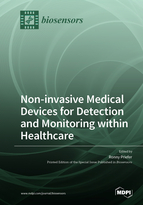Non-invasive Medical Devices for Detection and Monitoring within Healthcare
A special issue of Biosensors (ISSN 2079-6374). This special issue belongs to the section "Biosensors and Healthcare".
Deadline for manuscript submissions: closed (31 August 2022) | Viewed by 57224
Special Issue Editor
Interests: biosensors; Alzheimer’s; diabetes; cancer; infection
Special Issues, Collections and Topics in MDPI journals
Special Issue Information
Dear Colleagues,
Biosensors have changed our world in incalculable ways; from blood glucose monitors to pacemakers and beyond. These devices have allowed individuals to live longer and healthier lives. However, a limitation to many is the requirement for these medical devices to be invasive in nature. This has, in turn, lowered the adherence levels of some of these sensors, such as the aforementioned blood glucose monitors. Likewise, the invasiveness of certain technologies leads to potential infections, elevated healthcare costs, and decreased market adoption. Thus, there has been an explosion of research in the area of non-invasive medical devices for either the detection or monitoring of a variety of medical conditions. These include through skin detection, breath analysis, urine metabolites, etc., and have been investigated within diabetes, cancer, diets, and lactose intolerance, to name but a few. This Special Issue is designed to showcase advances within the non-invasive detection settings within healthcare.
Prof. Dr. Ronny Priefer
Guest Editor
Manuscript Submission Information
Manuscripts should be submitted online at www.mdpi.com by registering and logging in to this website. Once you are registered, click here to go to the submission form. Manuscripts can be submitted until the deadline. All submissions that pass pre-check are peer-reviewed. Accepted papers will be published continuously in the journal (as soon as accepted) and will be listed together on the special issue website. Research articles, review articles as well as short communications are invited. For planned papers, a title and short abstract (about 100 words) can be sent to the Editorial Office for announcement on this website.
Submitted manuscripts should not have been published previously, nor be under consideration for publication elsewhere (except conference proceedings papers). All manuscripts are thoroughly refereed through a single-blind peer-review process. A guide for authors and other relevant information for submission of manuscripts is available on the Instructions for Authors page. Biosensors is an international peer-reviewed open access monthly journal published by MDPI.
Please visit the Instructions for Authors page before submitting a manuscript. The Article Processing Charge (APC) for publication in this open access journal is 2700 CHF (Swiss Francs). Submitted papers should be well formatted and use good English. Authors may use MDPI's English editing service prior to publication or during author revisions.







